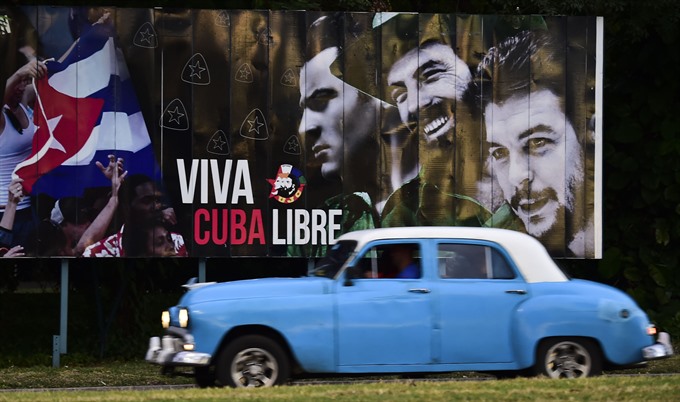 World
World

A titan of the 20th century who beat the odds to endure into the 21st, Castro died late on Friday after surviving 11 US administrations and hundreds of assassination attempts. No cause of death was given.
 |
| A car passes by a billboard reading "Long Live Free Cuba..." at the Revolution Square in Havana, on November 27, 2016. Cuban revolutionary icon Fidel Castro died late November 25 in Havana, his brother, President Raul Castro, announced on national television. Castro’s ashes will be buried in the historic southeastern city of Santiago on December 4 after a four-day procession through the country. — AFP/VNA Photo |
HAVANA – A titan of the 20th century who beat the odds to endure into the 21st, Castro died late on Friday after surviving 11 US administrations and hundreds of assassination attempts. No cause of death was given.
"It is a great loss. The most important thing is that he died when he chose, not when all the counter-revolutionaries wanted," said Carlos Manuel Obregon Rodriguez, a 43-year-old taxi driver in Havana.
"It may not be painful for everyone, but it is for a lot of people. I was born under this revolution and I owe Fidel a lot," he added.
President Raul Castro said his older brother’s remains would be cremated. There was no official confirmation of whether that had yet happened.
Funeral procession
No official events were scheduled on Sunday but a series of memorials will begin on Monday, when Cubans are called to converge on Havana’s Revolution Square.
"Tomorrow will be great. It will go down in history," Obregon said.
Castro’s ashes will then go on a four-day island-wide procession before being buried in the southeastern city of Santiago on Dec 4.
Santiago, Cuba’s second city, was the scene of Castro’s ill-fated first attempt at revolution in 1953 - six years before he succeeded in ousting the US-backed dictator Fulgencio Batista.
Castro ruled Cuba from 1959 until he handed power to Raul Castro in 2006 due to poor health.
Ordinary Cubans hailed him for providing free health care and education. But he cracked down harshly on dissent, jailing and exiling opponents.
Mourning in Havana
Havana was unusually quiet after alcohol sales were restricted and shows and baseball matches suspended.
"What can I say? Fidel Castro was larger than life," said a tearful Aurora Mendez, 82. She recalled a life in poverty before Castro’s revolution in 1959. "Fidel was always first in everything, fighting for the downtrodden and the poor," she said.
Fidel Castro, who came to power as a bearded, cigar-chomping 32-year-old, adopted the slogan "socialism or death" and kept his faith to the end.
He survived more than 600 assassination attempts, according to aides, as well as the failed 1961 US-backed Bay of Pigs invasion.
His outrage over that botched plot contributed to the Cuban missile crisis in 1962, when the Soviet Union accepted his request to send ballistic missiles to Cuba.
The confrontation following Washington’s discovery of the weapons pushed the world to the brink of nuclear war.
The USSR bankrolled Castro’s regime until 1989, when the Soviet bloc’s collapse sent Cuba’s economy into free-fall.
But Fidel managed to hang on, ceding power to his brother in July 2006 to recover from intestinal surgery.
Raul Castro has begun gradually to liberalise the economy and strengthen ties with former foreign foes.
Analysts said the elder brother’s presence still weighed on his brother’s rule.
Fidel Castro’s death "will probably speed up the economic reforms," said Jorge Duany, a Cuba specialist at Florida International University.—AFP




